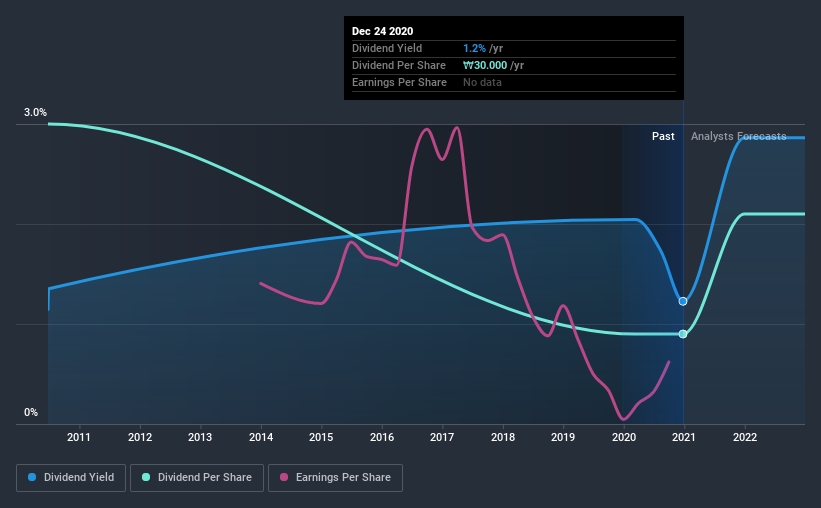- South Korea
- /
- Insurance
- /
- KOSE:A088350
Hanwha Life Insurance Co., Ltd. (KRX:088350) Is About To Go Ex-Dividend, And It Pays A 1.2% Yield

Regular readers will know that we love our dividends at Simply Wall St, which is why it's exciting to see Hanwha Life Insurance Co., Ltd. (KRX:088350) is about to trade ex-dividend in the next three days. This means that investors who purchase shares on or after the 29th of December will not receive the dividend, which will be paid on the 31st of March.
Hanwha Life Insurance's next dividend payment will be ₩30.00 per share. Last year, in total, the company distributed ₩30.00 to shareholders. Calculating the last year's worth of payments shows that Hanwha Life Insurance has a trailing yield of 1.2% on the current share price of ₩2445. Dividends are a major contributor to investment returns for long term holders, but only if the dividend continues to be paid. So we need to check whether the dividend payments are covered, and if earnings are growing.
Check out our latest analysis for Hanwha Life Insurance
Dividends are usually paid out of company profits, so if a company pays out more than it earned then its dividend is usually at greater risk of being cut. Hanwha Life Insurance paid out just 12% of its profit last year, which we think is conservatively low and leaves plenty of margin for unexpected circumstances.
When a company paid out less in dividends than it earned in profit, this generally suggests its dividend is affordable. The lower the % of its profit that it pays out, the greater the margin of safety for the dividend if the business enters a downturn.
Click here to see the company's payout ratio, plus analyst estimates of its future dividends.

Have Earnings And Dividends Been Growing?
When earnings decline, dividend companies become much harder to analyse and own safely. If earnings decline and the company is forced to cut its dividend, investors could watch the value of their investment go up in smoke. Hanwha Life Insurance's earnings per share have fallen at approximately 12% a year over the previous five years. Ultimately, when earnings per share decline, the size of the pie from which dividends can be paid, shrinks.
The main way most investors will assess a company's dividend prospects is by checking the historical rate of dividend growth. Hanwha Life Insurance has seen its dividend decline 11% per annum on average over the past 10 years, which is not great to see. It's never nice to see earnings and dividends falling, but at least management has cut the dividend rather than potentially risk the company's health in an attempt to maintain it.
Final Takeaway
Has Hanwha Life Insurance got what it takes to maintain its dividend payments? Earnings per share have shrunk noticeably in recent years, although we like that the company has a low payout ratio. This could suggest a cut to the dividend may not be a major risk in the near future. At best we would put it on a watch-list to see if business conditions improve, as it doesn't look like a clear opportunity right now.
However if you're still interested in Hanwha Life Insurance as a potential investment, you should definitely consider some of the risks involved with Hanwha Life Insurance. To help with this, we've discovered 3 warning signs for Hanwha Life Insurance (1 makes us a bit uncomfortable!) that you ought to be aware of before buying the shares.
We wouldn't recommend just buying the first dividend stock you see, though. Here's a list of interesting dividend stocks with a greater than 2% yield and an upcoming dividend.
When trading Hanwha Life Insurance or any other investment, use the platform considered by many to be the Professional's Gateway to the Worlds Market, Interactive Brokers. You get the lowest-cost* trading on stocks, options, futures, forex, bonds and funds worldwide from a single integrated account. Promoted
If you're looking to trade Hanwha Life Insurance, open an account with the lowest-cost platform trusted by professionals, Interactive Brokers.
With clients in over 200 countries and territories, and access to 160 markets, IBKR lets you trade stocks, options, futures, forex, bonds and funds from a single integrated account.
Enjoy no hidden fees, no account minimums, and FX conversion rates as low as 0.03%, far better than what most brokers offer.
Sponsored ContentValuation is complex, but we're here to simplify it.
Discover if Hanwha Life Insurance might be undervalued or overvalued with our detailed analysis, featuring fair value estimates, potential risks, dividends, insider trades, and its financial condition.
Access Free AnalysisThis article by Simply Wall St is general in nature. It does not constitute a recommendation to buy or sell any stock, and does not take account of your objectives, or your financial situation. We aim to bring you long-term focused analysis driven by fundamental data. Note that our analysis may not factor in the latest price-sensitive company announcements or qualitative material. Simply Wall St has no position in any stocks mentioned.
*Interactive Brokers Rated Lowest Cost Broker by StockBrokers.com Annual Online Review 2020
Have feedback on this article? Concerned about the content? Get in touch with us directly. Alternatively, email editorial-team (at) simplywallst.com.
About KOSE:A088350
Hanwha Life Insurance
Provides various insurance products to individual and corporate customers in South Korea, Vietnam, China, Indonesia, and internationally.
Undervalued with adequate balance sheet and pays a dividend.


